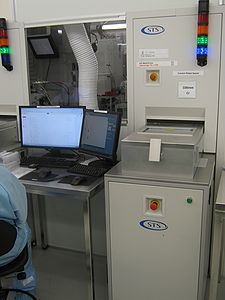Specific Process Knowledge/Etch/ICP Metal Etcher: Difference between revisions
Appearance
No edit summary |
|||
| Line 1: | Line 1: | ||
'''Feedback to this page''': '''[mailto:labadviser@danchip.dtu.dk?Subject=Feed%20back%20from%20page%20http://labadviser.danchip.dtu.dk/index.php/Specific_Process_Knowledge/Etch/ICP_Metal_Etcher click here]''' | '''Feedback to this page''': '''[mailto:labadviser@danchip.dtu.dk?Subject=Feed%20back%20from%20page%20http://labadviser.danchip.dtu.dk/index.php/Specific_Process_Knowledge/Etch/ICP_Metal_Etcher click here]''' | ||
[[Category: Equipment |ICP Metal]] | |||
== The ICP Metal Etcher == | == The ICP Metal Etcher == | ||
Revision as of 13:59, 31 March 2014
Feedback to this page: click here
The ICP Metal Etcher

The ICP Metal Etcher allows you to dry etch a small set of metals that includes aluminium, titanium, chromium, titanium tungsten and molybdenum (along with the related oxides and nitrides). It is, despite its name, strictly forbidden to etch (or expose to plasma) other metals. In order to do so use the IBE/IBSD Ionfab 300.
The user manual, user APV and contact information can be found in LabManager:
Equipment info in LabManager
Process information
Standard recipes
Other etch recipes
| Purpose | Dry etch of |
| |||||||||
|---|---|---|---|---|---|---|---|---|---|---|---|
| Performance | Etch rates |
| |||||||||
| Anisotropy |
| ||||||||||
| Process parameter range | Process pressure |
| |||||||||
| Gas flows |
| ||||||||||
| Substrates | Batch size |
| |||||||||
| Substrate material allowed |
| ||||||||||
| Possible masking material |
|
